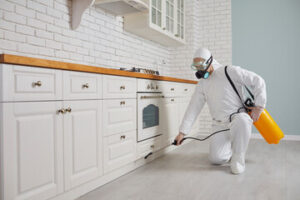Usually, Pest Control Trophy Club TX goals include prevention and suppression. Suppression reduces pest populations to levels below those causing unacceptable harm.

Physical pest control includes eliminating breeding grounds and closing off hiding places. For example, removing clutter and sealing cracks, crevices, and holes with caulk or steel wool can help prevent pest infestations.
There are many ways to prevent pests from infesting a home or business, such as maintaining cleanliness and good hygiene, sealing entry points and removing food and water sources. If pesticides are necessary, they should be used as sparingly as possible and only in the places where pest infestation is a serious concern.
A common way that pests invade homes and businesses is through small cracks or holes around doors, windows and other areas of the structure. Performing regular inspections of the property can help identify and seal any problem areas. In addition, it is a good idea to check for leaky pipes and other problems that can cause water or moisture problems in crawl spaces or basements. Moisture is a very attractant to certain pests such as roaches, mice and mosquitoes.
Other important ways to prevent pests is to ensure that all garbage and debris are disposed of on a regular basis, and to make sure that trash receptacles are kept away from the building and sealed tightly. Cleanup of spills and crumbs should be done promptly, and all food should be stored in airtight containers to prevent pests from getting at it. It is also a good idea to store garbage in plastic bags rather than open cans, as rodents are often attracted to the scent of the food inside cans.
It is also important to pay attention to auditory cues, as a number of pests can be heard scurrying around walls and other areas where they are hiding. Scratching noises, especially in the attic or in walls, are often signs that there is a pest infestation. Likewise, chirping or buzzing noises can be signs of pests such as mice, rats, ants and bees. It is very important to take action when these sounds are heard in order to prevent the pests from spreading further. In some cases, the threshold level that forces action is zero: even a single pest in an area is unacceptable. In these cases, the control strategy must be one that reduces the pest population to a level below what is acceptable.
Suppression
Pests can do a lot of damage in their quest to reproduce and thrive. They can also pose health hazards by spreading diseases, especially when their droppings come in contact with humans. To avoid this, it’s important to understand what makes a pest problem and take the necessary precautions to prevent it from happening in the first place.
Preventing pests from infesting homes or businesses can be done by removing their food, water and shelter sources. This includes storing food in tightly sealed containers and removing garbage regularly. It also means fixing leaky plumbing and reducing clutter in areas where pests can hide. It’s also important to be aware of seasonal changes in pest potential. For example, cockroaches tend to invade homes during the winter when they seek warmth and food. Similarly, mosquitoes are more active during summer when they breed and feed on blood.
Physical barriers are another effective pest control measure. These include traps, screens, fences, and other devices that limit the movement of pests or alter their environment. Cultural controls are also useful and can be used in conjunction with other methods to reduce pests. Plowing, crop rotation, cleaning of greenhouse and tillage equipment, mulching, and managing irrigation schedules are all examples of cultural controls.
Biological controls involve conserving or releasing natural enemies to lower the number of a pest species. This is a common part of integrated pest management (IPM) programs. For example, releasing predators or parasitoids can lower mite populations in orchards, and nematodes that kill harmful soil grubs can be introduced to reduce the number of greenhouse whiteflies.
Chemicals are sometimes used to augment the effects of physical and biological controls. The use of pheromones and juvenile hormones to control insect larvae, for example, can be very effective. These methods can be particularly useful when the population of a pest is too high to tolerate, but when there’s not enough time to wait for natural predators and pathogens to increase in abundance. Biological controls are usually not a substitute for preventive measures, however, because there’s often a delay between pest population increases and the increase in enemy populations.
Eradication
Pests are organisms that negatively impact humans, our activities or property. They can carry diseases or damage crops, livestock and the environment. They may also cause harm to people by biting or stinging, such as bed bugs, hornets and wasps. Some are considered a nuisance, such as flies and mosquitoes, while others are serious pests, such as rodents, cockroaches and fleas.
While eradication is a desired endpoint in some pest control situations, it is rare because it is so difficult to achieve. It requires strong monitoring to identify and count infected persons, along with rapid intervention to prevent transmission. In addition, eradication efforts must be undertaken at the local, community, regional and global levels. There are many reasons why eradication efforts may fail: the emergence of a nonhuman host in place of the original target organism (as with guinea worm), insecticide resistance (as with malaria and yellow fever) or political problems (as with poliomyelitis eradication).
Chemical
A chemical solution is a fast way to get rid of an unwanted pest, especially when it is targeted directly. These solutions include repellents, which deter pests from entering an area, and insecticides, which kill insects. Chemical pesticides can pose health and environmental hazards upon exposure, and some are more toxic than others.
Biological
A biological approach is a safe and environmentally friendly method of pest control. Biological methods use natural enemies or parasites to reduce pest populations, such as the introduction of ladybugs to reduce the number of aphids on a plant or introducing bacteria to plants that are naturally resistant to a specific pest. Another example is nematodes, which are microscopic worms that are beneficial to the soil and attack insects such as grubs, fleas and ants.
To ensure that a pest control service is using proper safety measures, always ask to see the pesticide label. The label will indicate the EPA registration number, as well as where and how the pesticide may be used. After the application, you should make sure that any leftover pesticide or pesticide container is properly disposed of. The pesticide service provider should be able to provide you with information about the chemical, including its material safety data sheet, and how to dispose of any residue or empty containers.
Natural Forces
Using natural forces to fight pests can reduce or even eliminate the need for chemical pesticides. Natural enemies of a pest, such as parasites, predators and pathogens, can control pest populations. The use of natural enemies in pest management is known as biological control. Biological control involves releasing natural enemies into an area to attack or injure the pest, and can include introducing new natural enemies that were not previously present in the area.
Many researchers and farmers have argued that conserving the natural habitat surrounding farm fields can help to prevent pest infestations by providing an environment that is less hospitable to the pests.
In fact, in some cases the presence of natural habitat near a crop actually increases pest abundance. This may be due to the competition between crops and natural enemy organisms for food or space, the availability of water or the presence of other factors that influence pest behavior.
A multifaceted approach to reducing the need for pesticides is often used in integrated pest management (IPM) programs. This approach involves evaluating the environmental conditions that lead to pest problems, and selecting control strategies that take into account both the threat to the crop and the effects on non-target species.
Making the environment less hospitable to pests is one way of controlling them, as is the use of physical or mechanical controls such as traps, screens, barriers and fences. Altering the environment by limiting access to the resources necessary for pest growth is also useful, as is the introduction of organisms that disrupt the balance between a pest and its natural enemies. The use of neem oil, for example, can offer broad-spectrum protection against insect and fungal pests as well as nematodes that destroy the root systems of plants.

